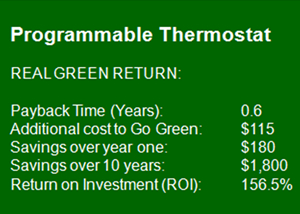
Programmable Thermostats are absolutely one of the most cost-effective ways to save money and the environment. Heating and Cooling accounts for about 35% - 45% of a home's energy cost. Programmable thermostats provide up to 20% savings when they are set to reduce the temperature 5 degrees at night and 10 degrees during the day when heating, or raise it an equal amount when cooling.
Not all homes have these, and if they do not, installing an ENERGY STAR® qualified programmable thermostat is the best bet. ENERGY STAR® is a joint program of the U.S. Environmental Protection Agency and the U.S. Department of Energy, helping Americans save money and protect the environment through energy efficient products and practices. Results are already adding up. In 2006, Americans, with the help of ENERGY STAR®, saved $14 billion on their utility bills, and saved enough energy to avoid greenhouse gas emissions equivalent to those from 25 million cars.
Programmable thermostats offer savings, comfort and convenience. A programmable thermostat costs $85-$125 and can save from $100-$300 for households every year on heating and cooling costs while making the home more comfortable. Savings are abundant if the house is kept a little bit cooler while sleeping or away from home. These savings are not hard to realize, as one can set a 'program' for the thermostat to follow, freeing a homeowner from adjusting the temperature manually. The ROI Calculation is based on saving about $15 a month over the course of the year.
However, the thermostat on the wall is not the only one in the house that can trim those pesky energy bills. Minding your refrigerator thermostats can save you a lot of money, but there are also many ways to make your refrigerator or freezer more efficient without touching the thermostat. Follow these suggestions and watch the savings pour in:
- Start by setting the refrigerator thermostat to maintain a temperature between 38 and 42 degrees Fahrenheit and the freezer thermostat to maintain a temperature between 0 and 5 degrees Fahrenheit. These temperatures will protect your food from spoiling while saving electricity. You may need to buy a fridge thermometer to do this, but they're cheap and you can pass it along to friends and family so they can do the same.
- Clean your fridge's condenser coils every few months. Removing dust and dirt from the condenser coils, found either behind or under your fridge, will improve the air circulation and efficiency. Make sure there are several inches of space between the back of the refrigerator and the wall. If the refrigerator is pushed up against the wall, heat gets trapped and causes the refrigerator to work harder.
- Fridges and freezers will use less energy if they're not near anything that heats up the room. If possible, put the refrigerator out of direct sunlight and away from the oven and dishwasher.
- If you're fridge has a power-save switch, use it.
- Be aware that "extra features" drain energy. If you aren't using them regularly, make sure they are turned off so they won't be using energy and raising your bill.
- Fill it up! A well-stocked freezer and fridge uses less electricity. Keep pitchers of water or blocks of ice in your fridge or freezer to prevent warm air from heating things up every time you open the door.
- Defrost your freezer regularly and give it a good scrub. A cleaned-up freezer requires less electricity to maintain a cool temperature.
- If you don't use the automatic ice maker, turn it off, especially if your freezer is on the top or bottom. It takes energy to pump water to the dispenser.
- Finally, remember what mom used to say about deciding what you want to eat before you open the door.
The ROI Data Source:
The ROI calculations are intended to serve as a guide to help you see the hierarchy of performance and payback. Given variations in energy consumption, house size, results will naturally vary. The calculations are based on comprehensive local and national research and a combination of reports from the U.S. Department of Energy, the EPA, ENERGY STAR® for Homes Program, US Green Building Council's LEED for Homes Program, American Council for an Energy-Efficient Economy (ACEEE), International Energy Conservation Code, PLUS information directly from University Studies, Architects, Manufacturer Specifications, Distributors, seasoned Builders and Installers, and Homeowners with actual Performance Feedback.
For more Return on Investment data and details on ways to save money and the environment, look here for Green Interior Home Remodeling opportunities. Every purchase you make is an opportunity to save.

